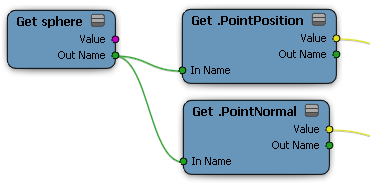Certain nodes can refer to elements in the scene using references. For example, references can specify things like:
References are resolved by name. Character strings are not case-sensitive. Object, property, and attribute names are separated by a period (.), for example, "grid.PointPosition" or "sphere.cls.WeightMapCls.Weight_Map.Weights".
You can specify a scene reference by using controls in a node's property editor, or by using Explore for Port Data on a node's context menu.
Nodes that use scene references have special controls in their property editors.

You can use the In Name and Out Name ports to connect references on Get Data and other nodes in sequence, like a daisy chain. For example, you can get "sphere" and then use that to get "sphere.PointPosition", "sphere.PointNormal", and so on. If you want to change "sphere" to "torus" later on, there's only one node that needs to be changed. This is particularly useful when creating compounds, because you only need to expose the leftmost reference.

References that are connected in this way are concatenated, so for example Get Data ("Self") plugged into Get Data ("PointPosition") results in "Self.PointPosition". You do not need to worry about periods at the beginning or end of the references — periods are automatically added or removed as necessary.
When a node has a reference connected to its In Name port, then the Explore button and Explore for Port Data command both start from the current path. For example, if you click Explore in the property editor of a leaf (left-most) Get Data, you can select anything starting from the scene root. However if a Get Data has a reference to a geometric object connected to its In Name, you can select properties and attributes on that object. Similarly if a node has a reference to a scene group connected, you can select any property or attribute that exists on all objects in that group (intersection).
If a Set Data compound has a string connected to its In Name port, the string is prepended to all attribute names that it sets. You can connect the object name, for example, "pointcloud", and then set any number of attributes such as PointPosition, PointVelocity, and so on. To add a new attribute when In Name is connected to a Set Data compound, you must first add a new port by right-clicking and choosing Insert Port Before or Insert Port After, then specify the attribute reference, and finally connect a value.
The token "self" always refers to the object on which the ICE tree is directly applied. This token allows you to create trees that are easily reusable because they don't depend on specific object names.
The exact context of a reference using "self" depends on the attribute. For example, "Self.PointPosition" is per point, "Self.EdgeLength" is per edge, "Self.PolygonArea" is per polygon, and "Self.NbPoints" is per object.
Other tokens that you can use are "this" (same as "self") and "this_model" (refers to the model that contains the object with the ICE tree).
If you have built an ICE tree using specific object names and want to make it more generic so that you can make a compound to use on other objects, you can automatically replace the object name with "Self".
Just as the keywords "self" and "this" refer to the object with the ICE tree, the keyword "this_model" refers to the model that contains the object with the ICE tree. By replacing references to a specific model name with "this_model", you can make a tree more generic and applicable to other objects.
Scene references are automatically maintained as you modify the scene.
If you have an object called "sphere" and you rename it to "ball", references to "sphere" are automatically updated to "ball".
If you delete the object named "sphere" instead, any references to it are invalid and the affected nodes become red. If you later add another object named "sphere", or rename an existing object to "sphere", then the references become resolved again.
If you add the object named "sphere" to a model named "Fluffy", references to "sphere" are automatically updated to "Fluffy.sphere". If the ICE tree is on an object in the Fluffy model, the references are updated to "this_model.sphere" instead.
 Except where otherwise noted, this work is licensed under a Creative Commons Attribution-NonCommercial-ShareAlike 3.0 Unported License
Except where otherwise noted, this work is licensed under a Creative Commons Attribution-NonCommercial-ShareAlike 3.0 Unported License